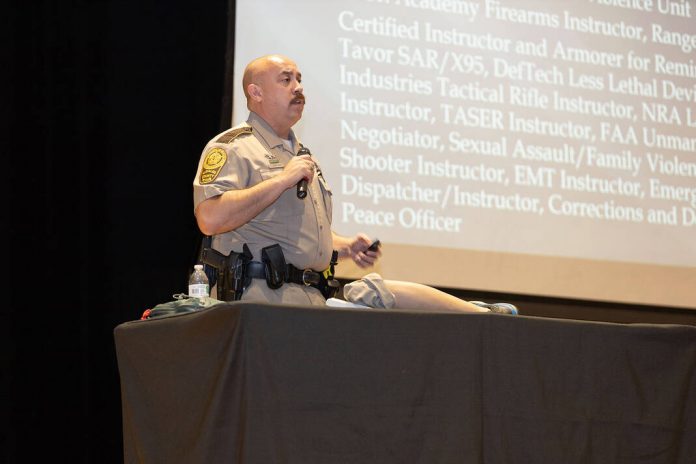EDINBURG — “We wish we didn’t have to have a presentation like this.”
Noel Oliveira’s words echoed across the room filled with first responders, educators and parents who sat here at the Edinburg Conference Center at Renaissance for a presentation Wednesday designed to save lives, a presentation that’s becoming more and more of a necessity following the Uvalde shooting massacre in May that claimed 21 lives at a local school.
DHR Health partnered with the Hidalgo County Sheriff’s Office to host an active shooter and critical incident training at the conference center Wednesday evening, where Oliveira, director of the Wound Care Center at DHR, introduced the first speaker of the evening, Senior Deputy Ricardo “Rick” Garcia.
Garcia served as the lead instructor and spoke to community members about active shooter statistics and best responses in such a situation.
According to Hidalgo County Sheriff J.E. “Eddie” Guerra, Garcia’s presentation is based on the agency’s Active Shooter Awareness Program, which has shown an increase in participants since its inception five years ago.
“We have trained over 45,000 civilian members of our community so far since we started this program,” Guerra said.
Garcia began the presentation by explaining that every shooter has one characteristic in common — predators are evolving and learning from past shooters.
It is for this reason that he and the sheriff’s office believe training the public on how to react to these situations is one of several means to prevent mass casualties.
“For years all we have been doing is training law enforcement — get there faster, get them better equipment, get them better training,” explained Garcia, adding that law enforcement is well-trained for emergency situations.
Garcia added that while authorities have their own set of training protocols, the Uvalde shooting created a sense of urgency to provide the public with important information on how to react if in a critical emergency.
“You are there when it happens and you have to do something for the four, five, six minutes that it takes law enforcement to get there,” Garcia said.
With this type of training, Garcia hopes to inform community members about the basic tools and knowledge available to them that lean more on “primitive” survival instincts. For instance, Garcia repeated the phrase, “Run. Hide. Fight.”
The thought is that individuals in emergency situations should first flee from danger and to a place hidden from a perpetrator, and the last resort being to fight for one’s life if left with no choice.
“We want to help people understand that it is something that they can do. They don’t have to be victims,” Garcia said.
For 67-year-old Richard Sanchez, a retired registered nurse and educator, the training serves as the basis for a “relay team” where civilians and police work together to more effectively and efficiently stop active shooters.
“Our children are our future,” Sanchez said. “We need to protect them not just educate them, but protect them to make sure that they succeed and that nobody comes in and hurts or kills our children.”
The safety coordinator for the Sharyland Water Supply Corporation, Jorge Silva, 37, was among the attendees at Wednesday’s training and said he felt compelled to be there to share the knowledge with his coworkers.
“Exposure and knowledge,” Silva said when asked what brought him to the training Wednesday.
He hoped to share what he’s learned from the training to his colleagues.
“I think the biggest takeaway honestly is when people realize two things, they realize that a lot of what we are talking about is really common sense and stuff that they really haven’t thought about — primitive instincts,” Garcia said. “The second biggest takeaway is the medical portion where we talk about trauma medicine and gunshot wounds … they realize that is actually really simple to help people that have these horrific wounds.”
Those who attended received information on bleeding control techniques with the use of tourniquets and other basic wound care materials. By providing information on emergency care, it helps prepare residents to know some basics on how to tend to wounds until first responders arrive.




